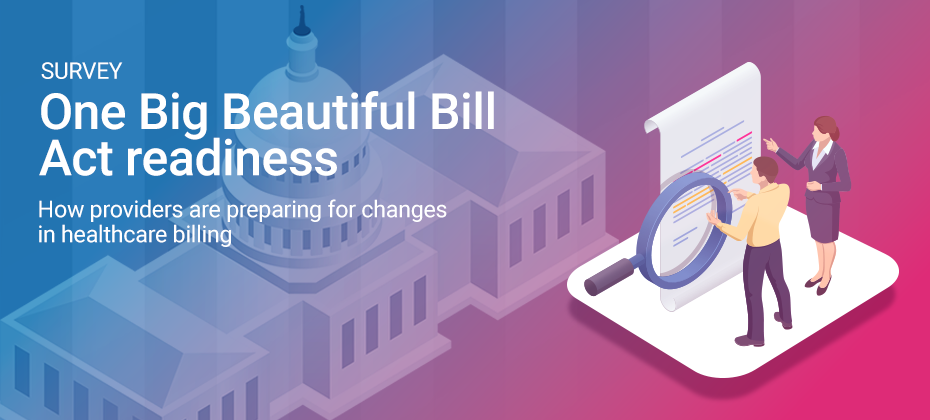Search Results for: artificial intelligence

Key takeaways: Manual work and disconnected claims management systems are often error-prone, resulting in delayed and denied claims. Technology, like automation and AI, can help healthcare organizations predict and prevent potential claims issues before submission. Implementing AI-powered claims management solutions should be a top priority for revenue cycle leaders. Healthcare claims denials are on the rise — but so is a new era of technology that can predict and prevent denials before they occur. Leveraging artificial intelligence (AI) for claims management can help organizations break the denial cycle and keep revenue cycles churning. In this article, we’ll explore how solutions like Experian Health’s innovative Patient Access Curator and AI Advantage™ are designed to help providers reduce claim denials with AI. Explore how Experian Health is reshaping the way health systems manage Coordination of Benefits. Learn how automation and AI are eliminating manual errors, reducing denials and unlocking millions in recoverable revenue. Watch now > Updating healthcare claims management tools Claims management is one of the most pressing challenges in healthcare billing. In Experian Health’s 2024 State of Claims survey, 77% of providers said they were moderately to extremely concerned that payers won’t reimburse them, largely due to changing payer policies and prior authorization requirements. Revenue cycle leaders know that good claims management is the key to healthy cash flow and a strong financial foundation. However, with patient volumes growing and complex payer rules increasing, traditional claims management solutions can no longer keep up. As a result, today’s healthcare organizations are feeling the squeeze to update their claims management processes and adopt solutions that rely on automation and AI-powered analytics to better predict, prevent and process denials. Predicting and preventing denials with artificial intelligence Healthcare providers can stop the denial spiral before it begins by capturing accurate and complete patient data at registration. According to Experian Health data, 46% of denials are caused by missing or incorrect information. Now, many healthcare organizations are accelerating their digital transformations by implementing automation and AI tools designed to predict and prevent denials. Automation creates consistent workflows, standardizes routine tasks and reduces human errors. At the same time, AI takes claims management to the next level by predicting denials, flagging claims errors before submission and prioritizing claims that need attention. Leveraging AI solutions that form a closed-loop system can ensure clean data at registration while predicting and preventing denials. Front-end solutions Tools like Patient Access Curator automatically find and correct patient data within seconds — across eligibility, Coordination of Benefits (COB) primacy, Medicare Beneficiary Identifiers (MBI), demographics and insurance discovery. Machine learning and predictive analytics allow providers to identify and correct bad data in real time, without the need for guesswork. Ken Kubisty, VP of Revenue Cycle at Exact Sciences, shares how Patient Access Curator improved eligibility processes, reduced errors and more. Back-end solutions Experian Health’s AI Advantage uses AI and machine learning to predict and prevent denials. AI Advantage not only predicts claim outcomes mid-cycle, but pushes urgent tasks to the front of the queue — allowing staff to prioritize the claims that matter most financially. Extending the automation advantage To minimize denials and delays, providers can look to implement automation and artificial intelligence across the entire claims ecosystem. For instance, Patient Access Curator and AI Advantage integrate seamlessly with solutions that manage the entire claims cycle, like Experian Health’s ClaimSource® — using real-time insights generated by ClaimSource to detect patterns and predict future payer behavior. Additionally, tools like Claim Scrubber can automate the claim scrubbing process — reducing potential errors, administrative burden and the need for costly reworks. Organizations can also add a denials workflow manager to automate and optimize the denial management portion of the claims cycle, improve staff productivity and speed up reimbursement. Artificial intelligence for claims management FAQs Want to learn more about how Experian Health’s AI tools can help reduce and prevent claim denials? Consider these commonly asked questions. What is AI Advantage, and how does it help with healthcare claims management? AI Advantage works in two stages of claims management, with two offerings: Predictive Denials and Denial Triage. In stage one, Predictive Denials uses AI and machine learning to look for patterns in payer adjudications and identify undocumented rules that could result in new denials. This solution also flags claims with a high potential of denial, so the right specialist can intervene before claims go to payers. After a claim has been denied, AI Advantage’s stage two component uses advanced algorithms to identify and segment denials based on their potential value. What is Patient Access Curator, and how does it help reduce claim denials? Experian Health’s Patient Access Curator is a robust patient intake and verification solution designed to eliminate errors that often result in denials, such as missing or incorrect information. Through AI and robotic process automation, Patient Access Curator automatically checks and verifies patient demographic information, insurance details, eligibility and more — reducing claim denial rates and administrative burden. How can AI Advantage and Patient Access Curator work together? Patient Access Curator and AI Advantage form a closed-loop system that offers healthcare organizations a smarter, faster and more scalable way to reduce denials and increase reimbursements while reducing administrative burden on staff. What are real-world results from using these solutions? Case study: Experian Health and Exact Sciences See how Exact Sciences used Patient Access Curator to reduce denials by 50% and add $100 million to their bottom line in six months. Case study: Experian Health and Schneck Medical Center See how Schneck Medical Center used AI Advantage to achieve a 4.6% average monthly decrease in denials. The bottom line: Providers can reduce claim denials with AI Leveraging artificial intelligence for claims management can improve the overall efficiency and accuracy of healthcare claims processing — leading to fewer denials and a more seamless patient experience. Instead of waiting for denials to occur before taking remedial action, healthcare organizations can stay a step ahead with claims management solutions that utilize AI and automation. These tools can help proactively detect errors and diagnose claims process weaknesses for a healthier revenue cycle. As Jason Considine, President at Experian Health, recently shared: “With the power of AI and predictive intelligence, we’re no longer waiting for denials to happen; we’re helping providers proactively prevent them. Tools like Experian Health’s Patient Access Curator and AI Advantage allow healthcare organizations to identify issues at the point of registration and throughout the revenue cycle, so teams can focus on care, not corrections. It’s about working smarter, reducing risk and protecting revenue.” Find out more about how Experian Health’s AI-powered claims management solutions help healthcare providers improve reimbursement rates and reduce denials. Learn more Contact us

Early diagnostics, remote patient monitoring and personalized care recommendations are just a few examples of how artificial intelligence (AI) is transforming the way healthcare is delivered. As technology advances, so do opportunities to optimize clinical and operational processes. With projected savings in the region of up to $360 billion annually, it's no surprise that 75% of healthcare executives believe AI has reached a turning point in their industry. Yet many providers are still just scratching the surface. Only a small percentage use AI for complex tasks like claim denial management, leaving the competitive advantage wide open. Understanding how these technologies work – and where to apply them for maximum impact – will be crucial to improve efficiency, remain competitive and above all, deliver excellent patient care. The power of AI in healthcare As the name suggests, artificial intelligence refers to a machine's ability to perform cognitive tasks that would normally be associated with humans, such as problem-solving and decision-making. It can spot patterns, learn from experience and choose the right course of action to achieve a goal. Natural language processing, robotics and machine learning might all be in the mix. AI in the healthcare industry has been found to support applications like: Improving diagnosis through the analysis of medical images AI-powered wearables and virtual nursing assistants Patient data management Reducing and preventing insurance claim denials. Artificial intelligence in healthcare isn't a substitute for human contact, which underpins the best patient care. However, by increasing accuracy and reducing costs, it can help clinicians and healthcare administrators make better decisions that support a positive patient experience across virtually all healthcare settings. AI & automation in healthcare: key benefits AI and automation deliver results in the three areas that matter most to healthcare organizations: improving the patient experience and care delivery, allowing staff to perform at their highest level, and increasing revenue. Boosting patient satisfaction through speed and accuracy Patient feedback has a few common themes: timely access to care, clearer communication and greater financial transparency. To meet these needs (and improve those feedback scores), healthcare providers should offer patients accurate, upfront information and reduce friction wherever possible. Tools like Patient Access Curator use AI to verify and update all necessary patient information at the front end, all at once, which drastically reduces the time and effort required to manage patient records. This streamlines patient intake and solves for bad data, which prevents claim denials and increases patient satisfaction. Bringing in more revenue by reducing claims errors The 2024 CAQH index estimates that 22% of current costs could be saved by shifting from manual revenue cycle processes to automated ones. Experian Health's State of Claims Survey 2024 suggests providers are eager to capitalize on this opportunity, with 51% seeking to reduce manual work. AI-driven solutions like Patient Access Curator and AI Advantage are designed specifically to meet these needs. Patient Access Curator automates insurance eligibility and coverage, scanning patient documentation for inaccurate information, and uses AI and robotic process automation to reduce manual errors. AI Advantage™ works to prevent denials before they happen, using predictive analytics to flag claims errors and alert staff to claims that fail to meet payer requirements. Improving staff performance by easing burnout The strain of manual processes doesn't just slow down operations. It's also a major cause of staff stress and burnout. Around half of healthcare staff report feeling burned out, costing the industry an estimated $4.6 billion each year. By taking repetitive tasks off busy employees' plates, AI can alleviate overwork and allow staff to focus on higher-value work, improving job satisfaction and productivity. In claims management, for example, AI Advantage, works in conjunction with ClaimSource®, to proactively identify claims with a high likelihood of denial prior to claim submission without staff intervention. This reduces the burden on staff while improving clean claim rates. How AI Advantage and Patient Access Curator improve patient care Experian Health's two flagship AI-based products go even further, offering new ways to use technology to improve patient care: Patient Access Curator uses AI and robotic process automation to streamline one of the most tedious parts of patient intake – verifying insurance eligibility and coverage. By automatically scanning patient records for errors and pulling up-to-date information from payer sources, it eliminates the guesswork and manual labor that bog down revenue cycle teams. The result is faster, more accurate eligibility verification and a smoother experience for both staff and patients. As Ken Kubisty, VP of Revenue Cycle at Exact Sciences, put it: “Within the first six months of implementing the Patient Access Curator, we added almost 15% in revenue per test because we were now getting eligibility correct and being able to do it very rapidly.” On the back end, AI Advantage – Predictive Denials acts as an early warning system for denials, scanning claims before they go out the door to catch errors and flag risky submissions so they can be corrected in time. Built on advanced AI and machine learning, the platform evaluates claims using historical payment data and real-time payer behavior. Its counterpart, AI Advantage – Denial Triage, picks up where Predictive Denials leaves off, sorting rejected claims according to their potential for reimbursement and prioritizing them based on financial impact. Together, they help providers minimize denials, resulting in faster reimbursement and freeing up resources that can be redirected to patient care. Case study: See how AI Advantage helped Schneck Medical Center achieve a 4.6% average monthly decrease in denials in the first six months. The future of AI in healthcare: what's next? As a quick glance at any newsfeed will confirm, AI's role in healthcare is only going to expand. Predictive analytics will give staff increasingly powerful insights and recommendations to maximize reimbursements, while minimizing the burden on the workforce. AI's ability to continually learn and improve means providers that embrace AI will be better placed to make full use of their data and adapt to the trends and challenges that affect patient care. As expectations grow and resources shrink, AI is likely to be the only way to deliver the scalable, responsive, high-quality care patients deserve. Discover how solutions like AI Advantage and Patient Access Curator use artificial intelligence in healthcare to help reduce claim denials, improve patient access and more. AI Advantage Patient Access Curator

For patient access leaders at large healthcare organizations, the pressure is mounting and has been building for some time. Healthcare claim denials are climbing. Staffing is stretched, and the tools healthcare organizations have relied on for years are no longer enough. But what if providers could stop denials before they start? Welcome to the new era of denial prevention in healthcare, powered by predictive intelligence. Experian Health's innovative artificial intelligence (AI) solutions, Patient Access Curator and AI Advantage™, were designed to help organizations prevent denials before they occur. Explore how Experian Health is reshaping the way health systems manage Coordination of Benefits. Learn how automation and AI are eliminating manual errors, reducing denials and unlocking millions in recoverable revenue. Watch now > The denial spiral explained: A systemic challenge in revenue cycle management Claim denials aren't just a back-end billing issue. They're a symptom of upstream breakdowns—often rooted in inaccurate or incomplete patient data at registration. According to Experian Health's 2024 State of Claims Survey, 46% of denials are caused by missing or incorrect information. And the cost of reworking a denied claim? $25 for providers and $181 for hospitals. The result? A denial spiral that drains resources, delays reimbursements, and frustrates patients and staff alike. Why Epic users are especially vulnerable While Epic is a powerful EHR platform, many Epic-based organizations still rely on staff to make complex decisions at registration. Questions like: Is this coverage primary? Should discovery be run? Is this data accurate? ...are often left to frontline staff. This guesswork leads to inconsistent outcomes—and denials. What's needed is a layer of predictive intelligence that works within Epic to automate and correct data before it becomes a problem. How Patient Access Curator fixes registration errors Patient Access Curator is that layer. Patient Access Curator is an all-in-one solution that automatically finds and corrects patient data across eligibility, Coordination of Benefits (COB) primacy, Medicare Beneficiary Identifiers (MBI), demographics and insurance discovery—within seconds. It integrates directly into Epic workflows, eliminating the need for staff to toggle between systems or make judgment calls on the fly. Instead of relying on registrars to catch every error, Patient Access Curator uses machine learning and predictive analytics to: - Identify and correct bad data in real time - Return comprehensive coverage directly into Epic - Reduce denials, write-offs, and vendor fees - Improve staff morale by removing administrative burden As one early-adopting Patient Access Curator client puts it: "If your current workflow still depends on frontline decisions, you're not just risking denials—you're building them in." Predictive intelligence in healthcare: AI Advantage at work While Patient Access Curator fixes the front end, AI Advantage tackles the middle of the revenue cycle, where claims are scrubbed, edited, and submitted. At Schneck Medical Center, AI Advantage helped reduce denials by 4.6% per month and cut denial resolution time by 4x. The tool flags high-risk claims before submission and routes them to the right biller for correction. It also triages denials based on the likelihood of reimbursement, so staff can focus on the claims that matter most. Together, Patient Access Curator and AI Advantage form a closed-loop system: - Patient Access Curator ensures clean data at registration - AI Advantage predicts and prevents denials mid-cycle - Both tools integrate seamlessly with Epic and ClaimSource® Why predictive denial prevention matters for patient access leaders By implementing denial management technology and predictive intelligence, healthcare teams aren't just managing workflows; they're managing risk. Every inaccurate field, every missed coverage, every manual decision is a potential denial. Patient Access Curator and AI Advantage remove that risk by replacing guesswork with certainty. And the benefits go beyond revenue: - Fewer denials mean fewer patient callbacks and less frustration - Cleaner data means faster reimbursements and fewer write-offs - Automation means staff can focus on patients, not paperwork As Jason Considine, President at Experian Health, recently shared: "Our mission is to simplify healthcare. That starts by getting it right the first time, before a claim is ever submitted. With the power of AI and predictive intelligence, we're no longer waiting for denials to happen; we're helping providers proactively prevent them. Tools like Patient Access Curator and AI Advantage allow healthcare organizations to identify issues at the point of registration and throughout the revenue cycle, so teams can focus on care, not corrections. It's about working smarter, reducing risk and protecting revenue." Denial prevention checklist: Preparing patient access teams for predictive denial prevention Denial prevention is here, but what if billing teams aren't quite ready? To move toward a predictive denial prevention strategy, healthcare organizations can invest in the following five areas: Audit front-end workflowsMap out every step from patient registration to claim submission. Identify where manual decisions are being made—especially around eligibility, COB, and insurance discovery. Ask: "Where are we relying on staff judgment instead of system intelligence?" Train staff on data quality awarenessReinforce the impact of inaccurate or incomplete data on downstream denials. Use real examples to show how a single missed field can lead to rework, write-offs, or patient frustration. Introduce the concept of "first-touch accuracy" as a team-wide goal. Evaluate Epic integration readinessAssess whether current Epic environments are configured to support automation tools like Patient Access Curator. Work with IT to assess whether the current setup allows for real-time data correction and coverage updates. Confirm that teams understand how new tools will integrate into their existing workflows, not replace them. Establish a denial prevention task forceBring together leaders from patient access, billing, IT and revenue cycle to align on goals. Assign ownership for key metrics like clean claim rate, denial rate, and registration accuracy. Use this group to pilot new tools like Patient Access Curator and AI Advantage and gather feedback from frontline users. Communicate the "Why" behind the changeFrame automation as a way to reduce burnout, not replace jobs. Highlight how tools like Patient Access Curator eliminate guesswork and free up staff to focus on patient care. Share success stories from peers (like Schneck Medical Center) to build confidence and momentum. The bottom line: Strategic denial prevention is the future Denial management is reactive. Denial prevention is strategic. For healthcare organizations using Epic, Patient Access Curator and AI Advantage offer a smarter, faster and more scalable way to increase reimbursements and improve the patient experience. Learn more about how Experian Health can help protect revenue, reduce staff burdens and reduce claim denials—starting at the first touchpoint. Learn more Contact us

Revenue cycle management (RCM) teams are facing a year of major change, with new regulations, tighter margins and the adoption of artificial intelligence (AI) increasing the pressure on workflows. This article outlines Experian Health’s five RCM predictions for 2026, along with tools to consider when building a resilient revenue cycle.

Key takeaways: Claim scrubbing is a critical part of claims management, designed to improve claim accuracy and catch errors before submission. Errors on claims are a leading cause for denials and reworks are costly and time-consuming. Organizations that adopt claim scrubber software, like Experian Health’s Claim Scrubber, typically see few denied claims and maximize reimbursements. Preventing claims denials is a top priority for 82% of healthcare organizations. Claim denial rates are climbing, and 68% of providers say submitting "clean claims" is more challenging than a year ago, per the latest Experian Health’s State of Claims 2025 data. Claim scrubber technology, like Experian Health's Claim Scrubber, can help healthcare providers submit clean claims from the start. Here’s what healthcare organizations need to know about using claim scrubbers to catch errors up front, minimize costly reworks and speed up reimbursements. What is claim scrubbing in healthcare? Claims scrubbing in healthcare is the process used by providers to increase claim accuracy and reduce errors, so that "clean claims" are submitted for reimbursement. Claim scrubbing is a critical part of the healthcare revenue cycle and a key component of an organization's overall claims management process. To minimize the risk of denials and costly rework, administrative staff typically review claims for accuracy before submission. Several areas of each claim are inspected and updated as needed, including patient information, coding, payer requirements and billing details. Why are claim scrubbers important? Claim scrubbers are important tools for healthcare organizations and are used to help teams submit clean and accurate claims the first time. These tools significantly limit the chance of a mistake slipping through due to human error or outdated information. With claim scrubbers, undercharges and denials are reduced; billing and payments are more timely; and providers see improved cash flow. Experian Health's Claim Scrubber, for instance, not only reduces the amount of claims errors but also streamlines the entire claim scrubbing process through automation. Claim Scrubber is built to seamlessly complement Experian Health's other claims processing solutions, including ClaimSource® and Denial Workflow Manager. Case study: Experian Health & State of Franklin Healthcare Associates See how State of Franklin Healthcare Associates used Claim Scrubber to expedite accounts receivable by 13% and reduce full-time employee requirements even as claims volume grew. What errors does a claim scrubber catch? Claim scrubbers are designed to identify and correct mistakes that may potentially lead to a denial. Missing claims data is the top reason a claim is denied, and more than a quarter of denials result from inaccurate or incomplete data collected at patient intake. A claim scrubber uses technology to cross-check claims for accuracy and to verify that all information is not only correct, but complete before submission. For example, Experian Health's Claim Scrubber solution uses automation to catch potential issues, like insurance information errors and billing code mistakes, before claims reach the payer. What's the difference between a claim scrubber and denial management software? A claim scrubber is designed to catch errors on claims before they are submitted, to make sure all information is accurate and complete. On the other hand, denial management software, such as Experian Health's Denial Workflow Manager, is used by providers to manage denied claims after they are submitted. As technology evolves, organizations are also rapidly adopting new denial management solutions that leverage artificial intelligence (AI) to prevent denied claims before they start and process denials more efficiently. On the front end, tools like Experian Health's Patient Access Curator™ (PAC) use AI to automatically check and verify patient demographic information such as insurance details and eligibility. Experian Health's AI Advantage™ works across two key stages of denial management to predict claim outcomes mid-cycle and pushes urgent tasks to the front of the queue. Together, PAC and AI Advantage form a closed-loop system that helps providers reduce denials, increase reimbursements and reduce administrative burden. Case study: Experian Health & OhioHealth See how OhioHealth cut denials by 42% with Patient Access Curator and solved claim errors at the source. How does Claim Scrubber work? Experian Health's Claim Scrubber is designed to consistently and reliably help healthcare staff produce clean and accurate claims that are more likely to be approved by payers. Claim scrubbing occurs within 2.7 to 3.0 seconds, ensuring speedy transaction processing that leads to faster reimbursements — even in batch mode. Claim Scrubber operates on a VPN connectivity feature that ensures secure and rapid responses for real-time integrations. And since the solution is an Experian Health cloud-based application, providers can reap Claim Scrubber's full benefits without the need for downtime, managing servers or regular maintenance. Here's a closer look at how Claim Scrubber works: Step 1: Claim Scrubber meticulously analyzes each line of every pre-claim to verify accurate coding and information before submission to the claims clearinghouse. Step 2: After completing the analysis, Claim Scrubber provides general and payer-relevant edits that pinpoint incorrect code combinations or other issues that could lead to claim denial. Step 3: Edits are stored within the Claim Scrubber portal and can be conveniently accessed by users from their PMS and HIS. Step 4: Reasons for flagging a claim are detailed, so users can make appropriate corrections before submission. (Users can make edits in alignment with payer policies, using Experian Health's comprehensive database of commercial payer policies and content.) Step 5: Claim Scrubber identifies when the billed amount is less than the payer-allowed amount, helping health systems catch and correct undercharges. How does Claim Scrubber help improve claims management? Experian Health's Claim Scrubber provides revenue cycle decision-makers and their teams with numerous benefits to help improve claims management. Optimizes claims processing by identifying potential coding and billing errors upfront. Ensures error-free claims submission to payers or clearinghouses. Prevents undercharges and underpayment. Increases first-time pass rates and prevents costly, time-consuming rework and rebilling that may result in a second rejection. Enables compliance with rapidly evolving price transparency rules by staying updated on coding variances. The bottom line: What can healthcare leaders expect for the future of claims scrubbing? Payer rules are rapidly evolving, along with industry regulations, and rising denial rates show no signs of receding. To keep up, it's imperative for revenue cycle leaders to submit the cleanest claims possible—the first time. With the right claims scrubbing technology in place, like Experian Health's Claim Scrubber, healthcare organizations will be better positioned to tackle the denial spiral head-on, boost cash flow and maximize revenue on every claim for years to come. See how Experian Health's Claim Scrubber is helping healthcare organizations submit clean, thorough claims and get paid faster and more accurately. Learn more Contact us

Hospitals that treat Medicaid patients should update their eligibility and billing systems now to prepare for the One Big Beautiful Bill Act (OBBBA), which will bring major changes to Medicaid.

Manual insurance eligibility checks are slow, error-prone and a leading cause of claim denials. Find out how automated insurance verification delivers real-time accuracy, fewer billing errors and faster reimbursements — helping providers protect revenue and improve patient care.

Denial management is the process of addressing why healthcare claims are rejected or denied, instead of resolving them after they occur. This article explores denial management strategies, why outdated processes fail and how AI-driven solutions can help reduce denials and streamline workflows.

As the healthcare industry prepares for the implementation of the One Big Beautiful Bill Act (OBBBA), it’s clear that readiness is not one-size-fits-all. Hospitals are leading the way, but most providers will need focused updates to their Medicaid/Medicare processes to ensure compliance and protect revenue. In October 2025, Experian Health surveyed 200 healthcare decision-makers to get a better understanding of their readiness levels, where they’ll be impacted and what they’re focusing on, following implementation of the OBBBA. Here are the results: To prepare for incoming changes from the OBBBA, revenue cycle leaders will need to accelerate their adoption of artificial intelligence (AI) and automated solutions. AI-powered tools, like Patient Access Curator, can help providers streamline insurance eligibility checks and improve claims accuracy. Other tools, like Patient Financial Clearance, can help providers support their patients, and minimize risks from uncompensated care. Is your revenue cycle team ready for OBBBA? Join us for an engaging and actionable three-part live webinar series to learn how to protect your financial performance before 2026 reforms take effect. Save your spot > Find out how Experian Health's revenue cycle management solutions can help your healthcare organization navigate upcoming regulatory shifts and changes. Learn more Contact us